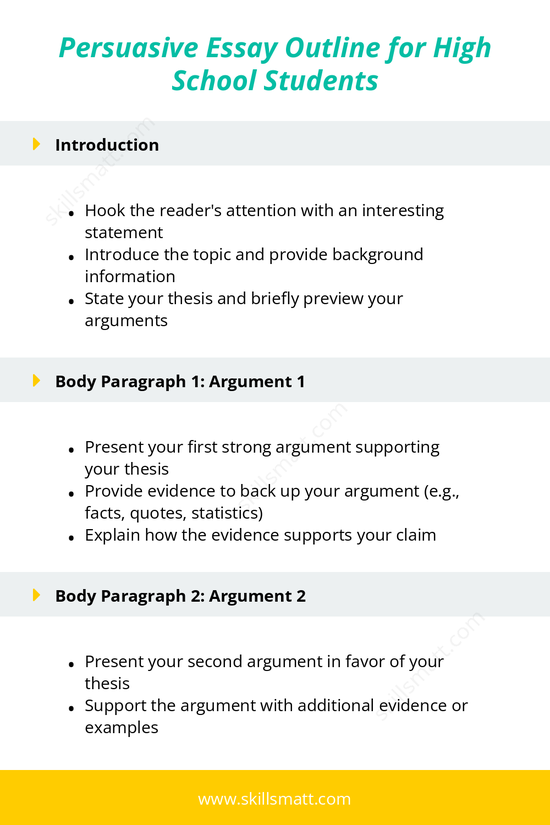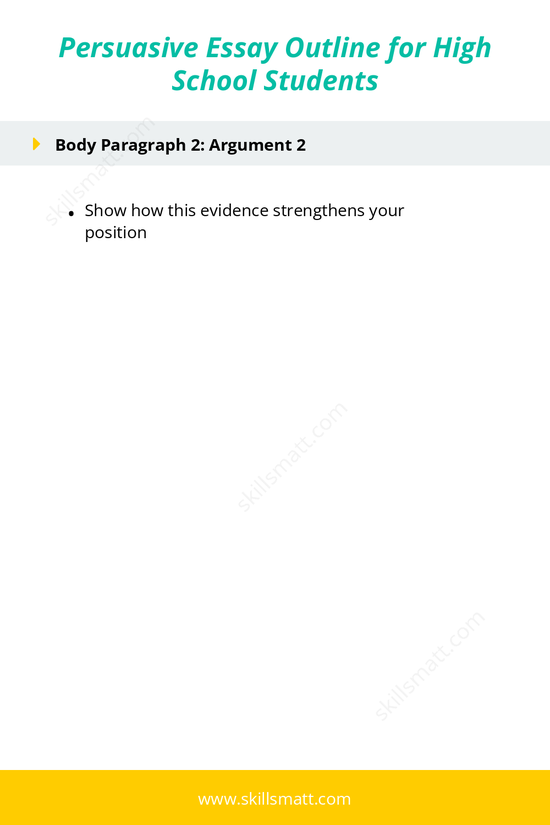Writing a persuasive essay is a valuable skill, especially for high school students. Persuasive essays are designed to convince readers to accept a particular point of view or to take a specific action. Whether it's convincing your peers to adopt a new idea or urging them to support a cause, having a clear and structured outline is essential. Below is a detailed outline of how to write a persuasive essay that can help students effectively argue their point of view and win their readers over.
Introduction
The introduction is your opportunity to hook the reader's attention and introduce the topic. A compelling introduction sets the stage for the rest of the essay.
- Hook the reader's attention with an interesting statement: Start with an engaging opening sentence that grabs the reader's attention. This could be a surprising fact, an anecdote, or a thought-provoking question.
- Introduce the topic and provide background information: Briefly explain the issue at hand. Provide enough context for the reader to understand the topic but avoid overwhelming them with too much information.
- State your thesis and briefly preview your arguments: Your thesis statement is the central argument of your essay. It should be clear, concise, and directly address the issue. In your introduction, also give the reader a preview of the arguments you will discuss in the body of the essay.
Body Paragraph 1: Argument 1
The first body paragraph should present your strongest argument in support of your thesis. This argument will set the tone for the rest of the essay, so it should be compelling and well-supported.
- Present your first strong argument supporting your thesis: Start with a clear topic sentence that introduces your first argument. This should be the main point that supports your overall thesis.
- Provide evidence to back up your argument (e.g., facts, quotes, statistics): Use credible sources to back up your argument. This could include statistics, facts, expert opinions, or direct quotes.
- Explain how the evidence supports your claim: Don't just present the evidence—explain why it's relevant and how it proves your argument.
Body Paragraph 2: Argument 2
The second body paragraph should present another argument that strengthens your position. This argument should complement the first but offer a new perspective or piece of evidence.
- Present your second argument in favor of your thesis: Introduce another compelling reason to support your thesis. This argument should not simply repeat the first but should offer new insights.
- Support the argument with additional evidence or examples: Just like the first body paragraph, use credible evidence to strengthen your position. Providing new examples or statistics will help reinforce your argument.
- Show how this evidence strengthens your position: Clearly connect the evidence to your thesis and explain how it makes your case stronger.
Body Paragraph 3: Counterargument and Refutation
In this section, you will acknowledge the opposing viewpoint and provide a rebuttal. This demonstrates that you have considered other perspectives and strengthens your argument by addressing potential objections.
- Acknowledge a counterargument to your thesis: Present the strongest opposing argument to your thesis. This shows that you are aware of different viewpoints and allows you to address them directly.
- Refute the counterargument with logical reasoning or evidence: Use evidence and reasoning to show why the counterargument is not valid or convincing. This could involve pointing out flaws in the opposing argument or offering more convincing evidence for your side.
- Reaffirm why your thesis is stronger: After refuting the counterargument, restate why your thesis remains valid. Emphasize the strength of your argument and why it holds up in light of the opposing viewpoint.
Conclusion
The conclusion is where you bring everything together and leave the reader with a final thought. A strong conclusion reinforces your thesis and encourages the reader to take action or think more deeply about the issue.
- Restate your thesis in a fresh way: Summarize your main argument, but present it in a way that doesn’t just repeat what you’ve already said. This gives the reader a sense of closure.
- Summarize the main points of your argument: Briefly go over the key arguments you’ve presented in the body paragraphs. This reinforces your message and reminds the reader of the strength of your position.
- End with a call to action or thought-provoking statement: End your essay with a strong final thought. This could be a call to action, urging the reader to take a specific action, or a thought-provoking question that encourages further reflection on the topic.
Writing a persuasive essay involves presenting compelling arguments, addressing counterarguments, and encouraging the reader to consider a particular viewpoint. By following this structured outline, high school students can create persuasive essays that are well-organized, convincing, and impactful.


